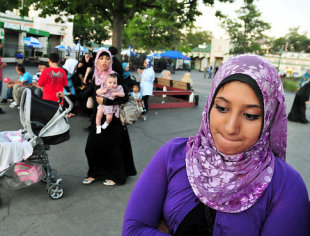Islamic dress code for women
The Islam instructs both Muslim men and Women to dress in a modest way. For women clothing must cover the entire body, only the hands and face may remain visible (According to some Fiqh Schools).
Allah says (interpretation of the meaning):
“And tell the believing women to lower their gaze (from looking at forbidden things), and protect their private parts (from illegal sexual acts, etc.) and not to show off their adornment except only that which is apparent (like palms of hands or one eye or both eyes for necessity to see the way, or outer dress like veil, gloves, head-cover, apron, etc.), and to draw their veils all over Juyubihinna (i.e. their bodies, faces, necks and bosoms, etc.) and not to reveal their adornment except to their husbands, their fathers, their husband’s fathers, their sons, their husband’s sons, their brothers or their brother’s sons, or their sister’s sons, or their (Muslim) women (i.e. their sisters in Islâm), or the (female) slaves whom their right hands possess, or old male servants who lack vigor, or small children who have no sense of the shame of sex. And let them not stamp their feet so as to reveal what they hide of their adornment. And all of you beg Allah to forgive you all, O believers, that you may be successful. ”[al-Noor 24:31]
Allah says (interpretation of the meaning):
“And as for women past child-bearing who do not expect wed-lock, it is no sin on them if they discard their (outer) clothing in such a way as not to show their adornment. But to refrain (i.e. not to discard their outer clothing) is better for them. And Allah is All-Hearer, All-Knower.” [al-Noor 24:60]
“Women past childbearing” are those who no longer menstruate, so they can no longer get pregnant or bear children.
Allah says (interpretation of the meaning):
“O Prophet! Tell your wives and your daughters and the women of the believers to draw their cloaks (veils) all over their bodies (i.e. screen themselves completely except the eyes or one eye to see the way). That will be better, that they should be known (as free respectable women) so as not to be annoyed. And Allah is Ever Oft¬Forgiving, Most Merciful.” [al-Ahzaab 33:59]
Allah says (interpretation of the meaning):
“O you who believe! Enter not the Prophet’s houses, except when leave is given to you for a meal, (and then) not (so early as) to wait for its preparation. But when you are invited, enter, and when you have taken your meal, disperse, without sitting for a talk. Verily, such (behavior) annoys the Prophet, and he is shy of (asking) you (to go), but Allah is not shy of (telling you) the truth. And when you ask (his wives) for anything you want, asks them from behind a screen that is purer for your hearts and for their hearts. And it is not (right) for you that you should annoy Allah’s Messenger, nor that you should ever marry his wives after him (his death). Verily! With Allah that shall be an enormity.” [al-Ahzaab 33:53]
Narrated by Safiyyah bint Shaybah (R.A) that ‘Aa’ishah (R.A) used to say: When these words were revealed – “and to draw their veils all over Juyoobihinna (i.e. their bodies, faces, necks and bosoms)” – they took their izaars (a kind of garment) and tore them from the edges and covered their faces with them. ( al-Bukhaari, 4481)
May Allah have mercy on the Muhaajir women. When Allaah revealed the words “and to draw their veils all over Juyoobihinna (i.e. their bodies, faces, necks and bosoms)”, they tore the thickest of their aprons (a kind of garment) and covered their faces with them. Abu Dawood (4102)
Narrated by ‘Aa’ishah (R.A) that the wives of the Prophet (pbuh) used to go out at night to al-Manaasi’ (well known places in the direction of al-Baqee’) to relieve themselves and ‘Umar used to say to the Prophet (pbuh), “Let your wives be veiled.” But the Messenger of Allah (pbuh) did not do that. Then one night Sawdah bint Zam’ah (R.A), the wife of the Prophet (pbuh), went out at ‘Isha’ time and she was a tall woman. ‘Umar called out to her: “We have recognized you, O Sawdah!” hoping that hijab would be revealed, then Allah revealed the verse of hijab.(al-Bukhaari, 146; Muslim, 2170.)
Narrated by Ibn Shihaab that Anas said: I am the most knowledgeable of people about hijab. Ubayy ibn Ka’b used to ask me about it. When the Messenger of Allah (pbuh) married Zaynab bint Jahsh (R.A), whom he married in Madeenah, he invited the people to a meal after the sun had risen. The Prophet (pbuh) sat down and some men sat around him after the people had left, until the Prophet (pbuh) stood up and walked a while, and I walked with him, until he reached the door of‘Aa’ishah’s(R.A) apartment. Then he thought that they had left so he went back and I went back with him, and they were still sitting there. He went back again, and I went with him, until he reached the door of ‘Aa’ishah’s (R.A) apartment, then he came back and I came back with him, and they had left. Then he drew a curtain between me and him, and the verse of hijab was revealed. (Al-Bukhaari, 5149; Muslim, 1428.)
Narrated by ‘Urwah (R.A) that ‘Aa’ishah (R.A) said: Prophet (pbuh) used to pray Fajr and the believing women would attend (the prayer) with him, wrapped in their aprons, then they would go back to their houses and no one would recognize them. (al-Bukhaari, 365; Muslim, 645.)
The material of Clothing must not be so thin that one can see through it and the clothing must hang loose so that the shape / form of the body is not apparent.











